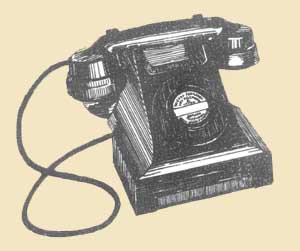 300
Series 300
Series
The British Post
Office 332 bakelite phone was introduced in Australia in 1939. It was
largely developed by Ericsson Telephones Ltd in Britain. It reduced the number
of mouldings from 10 to 5, giving greater production efficiency. The redesign
also did away with the fragile cradle of the 162 and 232, and its somewhat
unreliable switch contacts. The new phone was fitted with Ericsson handset
cords, which had been found to be resistant to tangling in use. The cords
were colour-coded to the later coloured models. All external metal parts were
chromed. A magneto model was not intended, but could be made up by adding
an external magneto generator in a separate box. The phone was made in phenol
formaldehyde, a compound generically called bakelite. It was ideal for thermosetting
moulding, was durable and of good insulating qualities, and was designed to
fix some of the inadequacies of the 162. The coloured models were made in
Imperial Chemical Industries' methylmethacrylate, tradenamed Diakon.
With some experience with the phone, the APO was able
to suggest a number of redesigns and modifications. The bell gongs were provided in different thicknesses of steel to give a slightly different
and more pleasing tone (parts 2 and
2A). A small Alnico generator used by the APO was reworked
to make it easier to turn, and fitted into the front of the case to make a magneto
phone, the 333/4. The 164 handset was replaced by the updated 184 model, with
the BPO No. 13 Inset transmitter. The note drawer was done away with because of
problems with it sticking and breaking, and a blank plate substituted. Initially
a wall model was not provided for by Ericssons, but this was added to the range
as the phone proved its worth. Except for the dial and cords, the entire phone
could be produced in Australia. This was a good move as World War 2 had started
and supplies of imported phones would become erratic. At this point the phone
was produced in black only. Some green and red phones had been imported before
the start of the War, but these purchases were suspended and not resumed, as experience
showed that the colored models still suffered from fading. Some of the initial
production was fitted with black-finished dials, but the chromed "StayBrite"
dial was soon substituted. 332CBTH and 332ATH were the original models.
The 333MTH was rare in Australia, but following the modifications suggested by
the APO and development of the smaller internal generator, it was produced as
the 334MTH. 330MTH was a WW2 Australian expedient telephone , using bells
from STC, small generator from GEC, standard 300 case from STC/AWA (now being
produced in Australia), and the 164 handset from Siemens. The handset will usually
be dated 1940. 312ATH was produced for duplex services. It had a pushbutton
mounted in front of the handset and a nameplate reading "Call Exchange".
A similar phone with a pushbutton marked "Ring" was used as
an extension phone off a switchboard or intermediate telephone. A version with
three pushbuttons marked "Main Extn , Extn Exch, Main Exch" was a replacement
for the old Teleintermediate and JS&B intermediate telephones. These phones
were issued under Serial/Item numbers, but do not appear to have been given a
300 model number. The 332 "Tropical" is a GEC phone. It was
brought in in small numbers around 1939, probably for evaluation. GEC made many
standard design phones for the British and Australian Post Offices, but also produced
their own customised models where they thought they could improve on the original.
It is marked "PMG 38" underneath. 336CBTH was a CB model fitted
with a generator as well. This was used as an extension phone off an extension
switch. The magneto was used to signal back to the main station. It was a British
Ericsson model N1326K.

The 338MTH is another magneto model. It is a later emergency model produced
by TMC using non-standard parts around 1955 - 1960, to keep up supplies of magneto
phones while the 800 series was being designed. Its most obvious difference
is the smaller bell gongs with one mounted vertically and one horizontally.
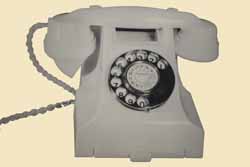

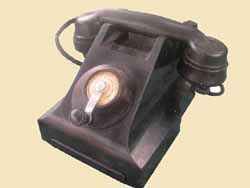
L to R: 332ATH Ivory with drawer for writing paper (an optional extra that the APO
dropped); 332CBTH with a blanking plate over the dial hole, 334MTH . The H for
"handset" was specified because at this time the APO charged a premium
for handset phones. This premium was soon dropped as sufficient supplies became
available.

This is an extremely rare transparent perspex version built for
training and display purposes. A limited production of an Ivory model was also
carried out. 


p>
The 300AWH version. The right picture shows its fold-down front for servicing.
It was also available in a CB wall model that was widely used in Public Telephones,
and a magneto model. 
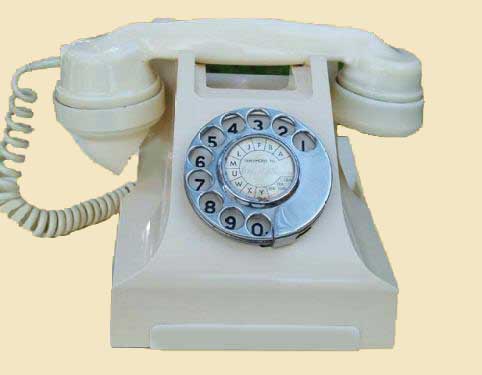

The 300 auto table models were *briefly" available in Jade Green, Chinese
Red and Ivory as well as black. Extra rental was charged for coloured sets.
Because of the fading problem they were eventually dropped from the range. India
Telephone Industries produced the phone in other colours and some of these are
currently being sold through antique shops.
 Courtesy
Denys Parker Courtesy
Denys Parker 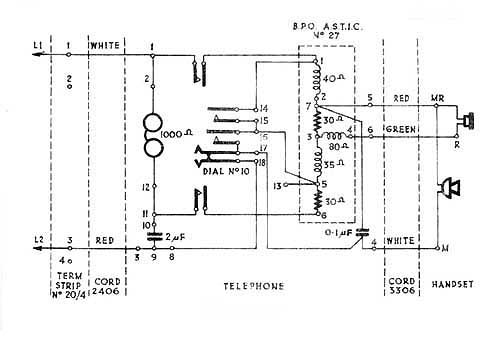
300AT circuit. For an article from the Australian Telecommunications Journal (1945), click HERE
 To
Kellogg 1040 To
Kellogg 1040  To
Tele 232 To
Tele 232  To
QuickFind To
QuickFind  If you have reached this page through a Search Engine, this will take you to the front page of the website If you have reached this page through a Search Engine, this will take you to the front page of the website
|